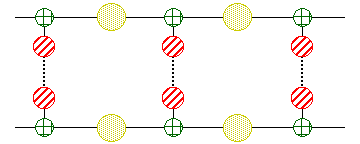Nucleic acid
A nucleic acid is a complex, high-molecular-weight biochemical macromolecule composed of nucleotide chains that convey genetic information. The most common nucleic acids are deoxyribonucleic acid (DNA) and ribonucleic acid (RNA). Nucleic acids are found in all living cells and viruses.
Chemical structure
The term "nucleic acid" is termed because of its prevalence in cellular nuclei, is the generic name of a family of biopolymers. The monomers themselves are called nucleotides. Each monomer consists of three components: a nitrogenous heterocyclic base, either a purine or a pyrimidine; a pentose sugar, and a phosphate group. Different nucleic acid types differ in the specific sugar found in their chain. For example, DNA contains 2-deoxyriboses. Likewise, the nitrogenous bases possible in the two nucleic acids are different: adenine, cytosine, and guanine are possible in both RNA and DNA, while thymine is possible only in DNA and uracil is possible only in RNA.
Nucleic acids may be single-stranded or double-stranded. A double-stranded nucleic acid consists of two single-stranded nucleic acids hydrogen-bonded together. RNA is usually single-stranded, but any given strand is likely to fold back upon itself to form double-helical regions. DNA is usually double-stranded, though some viruses have single-stranded DNA as their genome. The sugars and phosphates in nucleic acids are connected to each other in an alternating chain, linked by shared oxygens, forming a phosphodiester functional group. In conventional nomenclature, the carbons to which the phosphate groups are attached are the 3' and the 5' carbons. The bases extend from a glycosidic linkage to the 1' carbon of the pentose ring.
Hydrophobic interaction of nucleic acids is poorly understood. For example, nucleic acids are insoluble in ethanol, TCA, cold and hot water, and diluted hydrochloric acid; but they are soluble in diluted NaOH, alcohol and HCl.
In biology
Nucleic acids are primarily biology's means of storing and transmitting genetic information, though RNA is also capable of acting as an enzyme.
There are various common sources of DNA and RNA:
- Calf thymus DNA provides large linear DNA. It contains many breaks.
- T4 phage DNA is circular and can be isolated intact.
- Teichoic acids present in the cell walls of some gram-positive bacteria present a chemical structure resembling nucleic acids without the nucleobases.
External links
Template:ChemicalSources
| Nucleic acids edit |
|---|
| Nucleobases: Adenine - Thymine - Uracil - Guanine - Cytosine - Purine - Pyrimidine |
| Nucleosides: Adenosine - Uridine - Guanosine - Cytidine - Deoxyadenosine - Thymidine - Deoxyguanosine - Deoxycytidine |
| Nucleotides: AMP - UMP - GMP - CMP - ADP - UDP - GDP - CDP - ATP - UTP - GTP - CTP - cAMP - cGMP |
| Deoxynucleotides: dAMP - dTMP - dUMP - dGMP - dCMP - dADP - dTDP - dUDP - dGDP - dCDP - dATP - dTTP - dUTP - dGTP - dCTP |
| Nucleic acids: DNA - RNA - LNA - PNA - mRNA - ncRNA - miRNA - rRNA - siRNA - tRNA - mtDNA - Oligonucleotide |
Credits
New World Encyclopedia writers and editors rewrote and completed the Wikipedia article in accordance with New World Encyclopedia standards. This article abides by terms of the Creative Commons CC-by-sa 3.0 License (CC-by-sa), which may be used and disseminated with proper attribution. Credit is due under the terms of this license that can reference both the New World Encyclopedia contributors and the selfless volunteer contributors of the Wikimedia Foundation. To cite this article click here for a list of acceptable citing formats.The history of earlier contributions by wikipedians is accessible to researchers here:
The history of this article since it was imported to New World Encyclopedia:
Note: Some restrictions may apply to use of individual images which are separately licensed.
